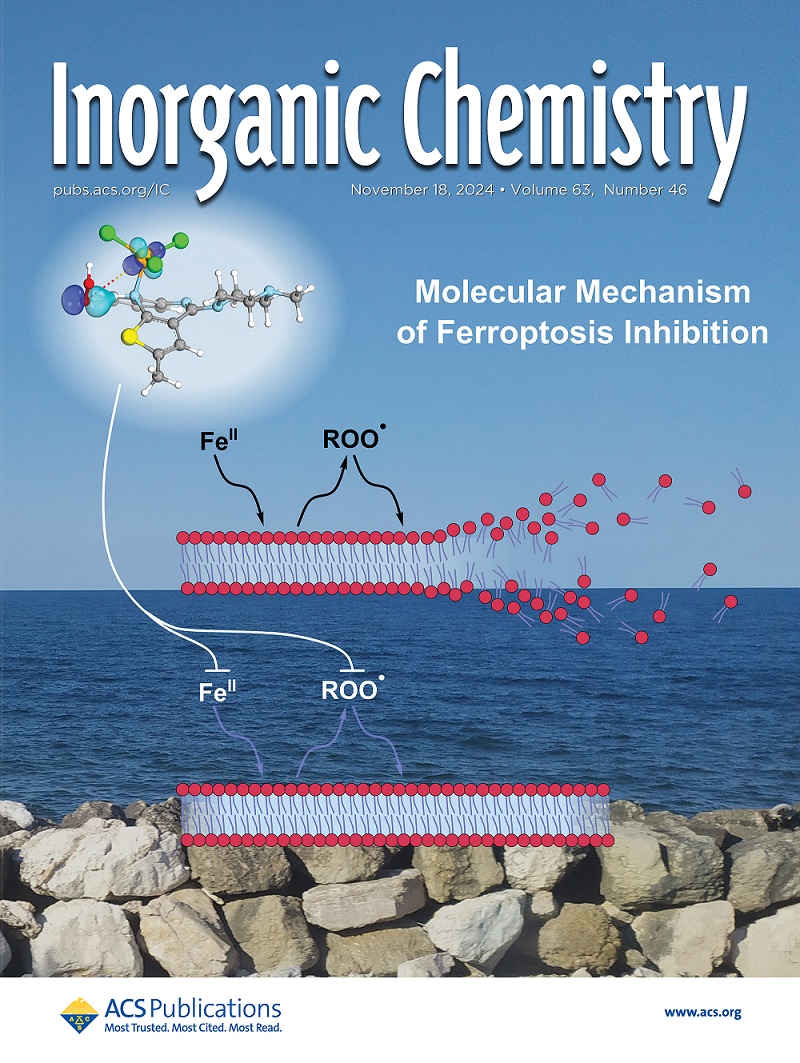由累赘三位连接体衍生的层状、桩堡聚集铜(I)异氰化物配位网络。
IF 4.3
2区 化学
Q1 CHEMISTRY, INORGANIC & NUCLEAR
引用次数: 0
摘要
异氰化物配位网络(isocn)是一类独特的框架材料,能够将低价金属中心组织成金属有机框架(MOF)型结构建筑单元(SBUs)。迄今为止,大多数报道的ISOCN材料都采用了线性双异氰化物连接剂。为了扩展与ISOCN形成相关的连接体结构,本文报道了阻碍三异氰化物连接体(CNArDipp2)3Ar3 (ArDipp2 = 2,6-(2,6-(i-Pr)2C6H3)2C6H2;Ar3 = 1,3,5-(C6H4)3C6H3)及其生成具有Cu(I)中心的网状材料的能力。在溶剂热条件下,用[Cu(NCMe)4]PF6在THF中处理(CNArDipp2)3Ar3,生成了新的网络cuocn -6单晶,该网络具有阳离子[Cu(THF)(CNArDipp2)3]+ SBUs,由三苯基苯核连接。在晶格结构上,CuISOCN-6呈现非互穿的二维蜂窝片,相当于hcb(6,3)网。通过(CNArDipp2)3Ar3连接体的三苯基苯核之间的非共价π-π堆叠相互作用,CuISOCN-6的蜂窝片以偏移的六层重复模式堆叠,具有不同的桩堡聚集体。通过气体吸附测量确定,桥墩聚集体结构元件压缩了CuISOCN-6的晶格结构,使其致密堆积且无孔。然而,由于层间桩桩结合,CuISOCN-6具有相当的热稳定性和化学稳定性。本文章由计算机程序翻译,如有差异,请以英文原文为准。
A Layered, Piedfort-Aggregated Cu(I) Isocyanide Coordination Network Derived from an Encumbering Tritopic Linker.
Isocyanide coordination networks (ISOCNs) are emerging as a distinct class of framework materials capable of organizing low-valent metal centers into metal-organic framework (MOF)-type structural building units (SBUs). To date, most of the reported ISOCN materials have employed linear ditopic diisocyanide linkers. In an effort to expand linker architectures associated with ISOCN formation, reported here is the synthesis of the encumbering tritopic isocyanide linker (CNArDipp2)3Ar3 (ArDipp2 = 2,6-(2,6-(i-Pr)2C6H3)2C6H2; Ar3 = 1,3,5-(C6H4)3C6H3) and its ability to produce network materials with Cu(I) centers. Treatment of (CNArDipp2)3Ar3 with [Cu(NCMe)4]PF6 in THF under solvothermal conditions produced single crystals of the new network, CuISOCN-6, which possesses cationic [Cu(THF)(CNArDipp2)3]+ SBUs linked by a triphenylbenzene core. The lattice structure of CuISOCN-6 revealed a noninterpenetrated two-dimensional honeycomb sheet corresponding to an hcb (6,3) net. The honeycomb sheets of CuISOCN-6 are stacked in an offset, six-layer repeating pattern that possess distinct piedfort aggregates assembled via noncovalent π-π stacking interactions between the triphenylbenzene core of the (CNArDipp2)3Ar3 linker. The piedfort aggregate structural elements compress the lattice structure of CuISOCN-6 such that it is dense packed and nonporous, as determined via gas sorption measurements. However, CuISOCN-6 possesses considerable thermal and chemical stability on account of interlayer piedfort association.
求助全文
通过发布文献求助,成功后即可免费获取论文全文。
去求助
来源期刊

Inorganic Chemistry
化学-无机化学与核化学
CiteScore
7.60
自引率
13.00%
发文量
1960
审稿时长
1.9 months
期刊介绍:
Inorganic Chemistry publishes fundamental studies in all phases of inorganic chemistry. Coverage includes experimental and theoretical reports on quantitative studies of structure and thermodynamics, kinetics, mechanisms of inorganic reactions, bioinorganic chemistry, and relevant aspects of organometallic chemistry, solid-state phenomena, and chemical bonding theory. Emphasis is placed on the synthesis, structure, thermodynamics, reactivity, spectroscopy, and bonding properties of significant new and known compounds.
 求助内容:
求助内容: 应助结果提醒方式:
应助结果提醒方式:


